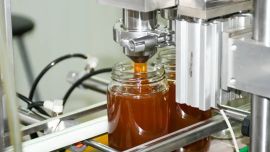In the humid Argentine pampas, soy plants stand healthy thanks to a good climate, good soil and the help of pesticides and fertilisers. But new data shows that only eight percent of empty pesticide containers are reused as they should be and millions are illegally discarded or recycled.
A law revised in 2018 ordered agrochemical companies to organise, operate, maintain and finance a comprehensive management system for the containers used on the market.
But of the 13 million containers sold in 2019 in Buenos Aires Province, scarcely one million were recovered. The remaining 12 million are estimated to have ended up on the black market, buried, dumped or burnt.
At the end of April, the Organismo Provincial para el Desarrollo Sostenible ("Provincial Organism for Sustainable Development," OPDS in its Spanish acronym) issued fines to around a hundred agrochemical companies worth a total US$8 million. Among those sanctioned were multinationals Bayer-Monsanto, Dupont and Syngenta.
A comprehensive plan to manage containers and their waste is in its infancy in Argentina, where almost 40 million hectares of land are sowed. The country has been a leading producer and seller of grains and oilseeds, especially soybeans, for years.
The proposed model of shared responsibility between farmers, manufacturers, distributors and the State is inspired by a similar system that has been in force in Brazil since 2002. There, annual recovery of containers exceeds 94 percent, according to data from the Nacional de Processamento de Embalagens Vazias (Brazilian Institute for the Processing of Empty Containers, INPEV).
Plastic poison
According to the law, farmers must carry out a triple washing process, as well as a perforation of all containers and then leave them at a collection centre after use.
These centres are managed by the Campo Limpio organisation, which includes around a hundred agrochemical companies responsible for 90 percent of the containers that reach the market.
"Brazil is a benchmark for the recovery [of the containers], but it took 20 years," Ignacio Stegmann, the head of Campo Limpio, told AFP.
"Here [in Argentina] we recovered 236,000 kilos of plastic in 2019, 1.5 million in 2020 and in 2021 we will exceed 2.5 million kilos," he said. Despite the achievements of more than one hundred travelling collection campaigns, it is still little.
At the beginning of May, inspectors found some 10,000 empty cans of pesticide out in the open in a field in Lincoln, 400 kilometres west of the Argentine capital.
"It is assumed that they were going to enter the normal recycling circuit, meaning the plastic could have been turned any product, one in contact with food, with the human body, it could've been toys even — all scandalous uses," Juan Brardinelli, head of the OPDS.
The only record of control for the containers are the annual statutory declarations of agrochemical companies.
"In Argentina the tracing of containers doesn’t exist — there are people who pass through the fields buying them. We need a change in behaviour," argues Stegmann who is committed to training producers in order "to raise awareness."
These containers have contained pesticides, fertilisers or other chemicals, some with components whose carcinogenic effect is under scrutiny, such as glyphosate.
However, in a country with 42 percent of its 45 million inhabitants in poverty, it's common for the containers to be scavaged and used to collect water for drinking or cooking in communities without access to potable water.
"This plastic is still toxic, we cannot guarantee that it does not have traces of agrochemicals," says Brardinelli. "That is why it is so important that they are recycled through formal channels and that the object that is going to be constructed with the material is defined," he explained.
Circular economy
A number of different projects are underway to promote the sustainable reuse of pesticide containers to manufacture things from road signs to sewer pipes or railway ties.
In Mendoza for example — the land of the famous Malbec wine — they have been trying to replace the estimated five million poles that are used each year in the vineyards with a wood-plastic composite, which would prevent the cutting down of 1.5 million trees.
Each two-metre-high pole contains about 10 kilos of plastic garbage and can also be used for perimeter fencing.
In addition to contributing to the circular economy, these are low-cost poles, manufactured without the use of water. They are also reusable and resistant to weather, humidity, insects and pesticides.
by Sonia Avalos, AFP


















Comments